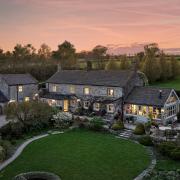Volunteers are more important than ever to the future of English Heritage properties as Terry Fletcher reports

Down the centuries Yorkshire’s great castles, monasteries and country estates always depended on a vast workforce to keep them functioning. Kings and princes, bishops and abbots, lords and ladies may have occupied the grand rooms but they would have been helpless without a huge community labouring away behind the scenes. Now history is repeating itself as English Heritage, reborn in April as an independent charity after decades as a government department, is appealing for extra volunteers to help to bring some of our most historic building to life. Already a huge army of volunteers is tackling jobs as varied as stewards to researchers and gardeners to guides.
Liz Page, historic properties director for the North, said: ‘Our volunteers have been incredibly important to us, not just to the running of our properties but also in enhancing the experience for our visitors by answering their questions and helping to bring history to life. They are going to be even more important to us now as we establish ourselves as a charity. We’ve a great variety of people in all kinds of roles and it is not just something for retired people to do. We have an incredibly diverse group of volunteers, people of all ages, including students and I would like to see even more young people engaging with the country’s history like this.’
One property where volunteering is already having a major impact is Mount Grace Priory, just off the A1 near Northallerton, where a team of volunteer stewards and guides has made it possible to reopen the old attics, which were previously closed off. Mount Grace is a rare site in that it has had several incarnations, creating layers of history which stretch back to the Middle Ages yet with connections that still reverberate on today’s news bulletins.
The manager, Barbara Owen said: ‘All those changes have created something unique here. The priory was built in 1398 and the monks lived like hermits in individual cells but it also stood on the main pilgrim route from York to Durham so although the monks were solitary they had quite a thriving guest house for travellers and it became quite a wealthy place.’

When it was dissolved in 1539 during Henry VIII’s Reformation the priory fell into ruin but the guest house survived and centuries later was bought by a wealthy Victorian Teesside iron master, Lothian Bell. He was reputed to be the sixth richest man in England at the time and had the house redesigned in the Arts and Crafts style, not to live in, since he had an even grander house nearby, but simply as a venue for parties. The family included Gertrude Bell, who became a very influential figure in Middle Eastern politics after the First World War and helped to draw up the still-contested boundaries of the modern states of Iraq and Syria.
It is this sprawling expanse of history which helped to persuade Anne Simpson, a retired civil servant to become a volunteer guide. She said: ‘I was born in Middlesbrough so I knew about Lothian Bell and my husband was born round here so I was already aware of much of the history but there is always something new to learn which keeps it interesting. Usually you are answering visitors’ questions but sometimes they are telling you things. It may be a memory they have of Mount Grace or perhaps a family connection with a grandparent who worked here. It’s always fresh.
‘I’m fascinated by what has gone on here. Imagine the people who lived here and the decisions they had to make, such as what to do during the Dissolution. Or imagine Gertrude Bell here. She had a lot going for her but it is astonishing what she achieved for a woman in those days. I’d love to have been a fly on the wall.’
Fellow volunteer, Philip Burton, 67, who came to Mount Grace after a second career as a National Trust administrator, agrees that the breadth of history at Mount Grace is a huge attraction, together with the range of people he meets on visits. ‘I’d recommend it to anyone,’ he said. ‘It’s always interesting and a lot more fun than just sitting round on your backside. There’s only so much gardening or painting anyone can do. I meet all kinds of people and it’s a pleasure seeing them get so much from the house and knowing you are helping them to understand it even better.’
At the other end of the age spectrum Margarite Whalley, a 20 year-old history and philosophy student at Lancaster University who became a volunteer when her parents moved to a house nearby, said: ‘My mum had already visited and told me they were looking for volunteers, which seemed a great way to get involved with the local community. It’s really good fun meeting the visitors and I enjoy learning about the house and the priory. Volunteering is something I’d recommend to other students – especially if they like talking.’
Find out more about volunteering for English Heritage at english-heritage.org.uk



























